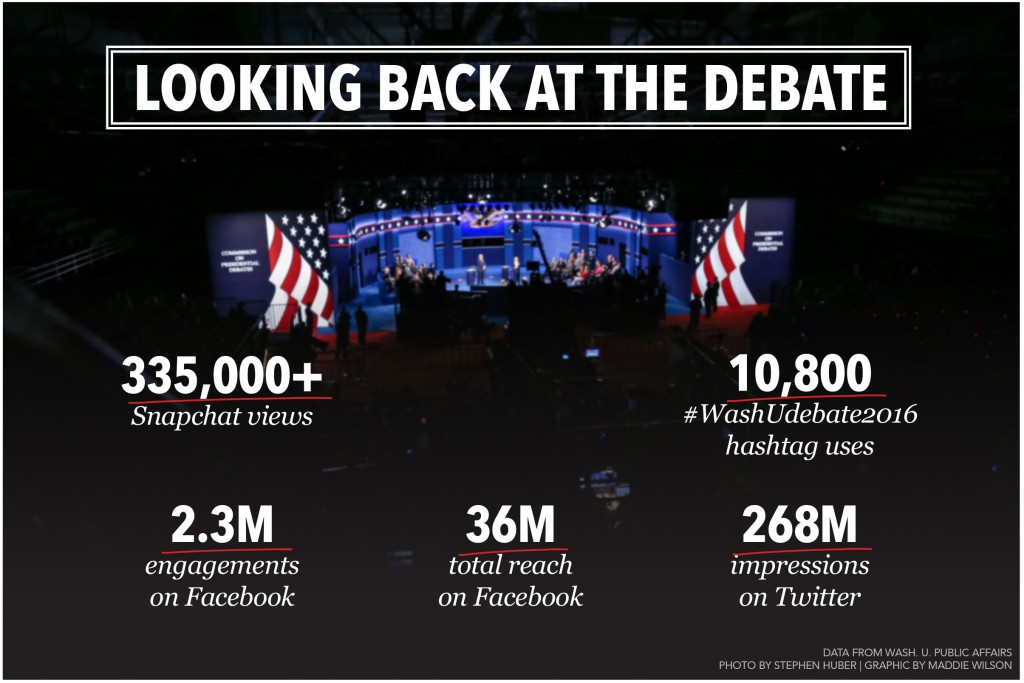National News
Reflections from debate chair, political journalist
Depending on who you ask, you’re likely to hear very different answers to the question “Who won the second presidential debate?” One cartoonist from the St. Louis Post-Dispatch argued it wasn’t even Donald Trump or Hillary Clinton—but Washington University.
The comic depicts both Clinton and Trump bruised and beaten on the floor of a boxing ring, while the referee holds up Chancellor Mark Wrighton’s hand in victory. ‘And the winner of tonight’s debate is…Wash U!’ it reads.

It’s now proudly displayed on the door of Steve Givens’ office; he’s an associate vice chancellor and served as the chair of the presidential debate steering committee.
And while some students were unsure what exactly they stood to gain from hosting the debate, Givens is sure that the returns on the University’s investment stand firmly above the associated costs—though, according to Givens, updates on costs are still unavailable.
Givens said he believes, and it is widely accepted that, when campuses are used as a platform for politicians and their media following, there are ample opportunities to rack up ‘free advertising dollars’ in the form of banners, signage and mentions.
“As that news was being created, we didn’t want anyone to forget that it was being made at Washington University in St. Louis. So all the banners and all that stuff looks a little over the top, but the truth is, that’s the power of hosting an event like this,” Givens said. “All those things add up to a win for us.”
A win, he argues, that may manifest gradually.
“It’s good for [students] and their pride, it’s good for the value of their degree, it’s good for them when they go job searching a few years from now,” Givens said.
And while bringing high-profile presidential candidates and politicians to campus in itself required an abundance of security and other considerations, accommodating the reporters and media members was equally crucial. Immediately after the debate ended, journalists flocked to ‘Spin Alley’ to collect sound-bites from surrogates and begin the process of reporting the stories that many look to in digesting the night’s events.
“All those people are just people,” Givens said, referring to the over 2,000 media members who watched the debate together in the media filing center and the adjacent Spin Alley. “They’re out looking for a good story. And what we need to give them is a place to work and the resources they need to get those things done.”
Jim Newell is one of those journalists; his career began as a blogger on ‘Wonkette’, an unconventional online political magazine, and he now writes as a staff reporter for Slate magazine. He spoke Monday night on his reflections of the second presidential debate and the state of political journalism in the face of a notoriously bizarre election season, with his friend from grade school, Tim Shenk, a postdoctoral research associate in the interdisciplinary program in humanities.
Newell chose to lay low during the Spin Alley festivities. He said he thinks the space is more of a forum for postgame analysis than actual news-breaking, but that he enjoys watching how both surrogates and journalists conduct themselves.
“[The surrogates] just tell you whatever they were going to tell you in the first place,” Newell said.
“It’s an experiment in absurdism, a little bit,” he added. “I do like to go out and see the way that they’re managing the way their campaigns are digesting what happened just then.”
As for the debate itself, Newell thinks it was punctuated by negativity.
“[People] will probably remember the less flattering moments,” Newell said. “They just sort of remember the worst moments and not necessarily the parts that look great for America, which was, I would think a lot of last night’s debate—it was pretty much a catfight.”
